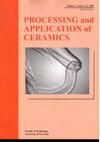掺铁氧化锌纳米花的多峰发射与形态演化
IF 0.8
4区 材料科学
Q3 MATERIALS SCIENCE, CERAMICS
引用次数: 0
摘要
采用共沉淀法合成了Fe掺杂氧化锌的纳米花和纳米块(即掺杂0、1、2、3、4和5% Fe的氧化锌)。XRD分析表明,掺铁量为1%的样品具有以Fe3+为主的纤锌矿结构,掺铁量较高的样品为Fe3+和Fe2+混合结构。观察了从纳米花到纳米块,再到纳米花和纳米块组合的形态转变。紫外光谱分析发现掺杂样品中存在多吸收区。由于Fe2+浓度的升高,掺5%纳米块的带隙扩大且表现不规则。测定了掺铁氧化锌纳米结构的室温光致发光特性。结果发现,掺入1%Fe的样品除了在黄色和红色区域检测到两个峰外,还在蓝色区域显示出两个峰,这对于光电领域的多功能应用可能是有趣的。本文章由计算机程序翻译,如有差异,请以英文原文为准。
Multi peak emission and morphological evolution of Fe-doped ZnOs nanoflowers
The nanoflowers and nanoblocks of Fe-doped ZnO (i.e. ZnO doped with 0, 1, 2, 3, 4 and 5% Fe) were synthesised by co-precipitation technique. XRD analysis showed that the samples have wurtzite structure containing mostly Fe3+ in the samples with 1% Fe and a mixture of Fe3+ and Fe2+ in the samples with higher amount of dopant. Morphology transformations from nanoflowers to nanoblocks, then into a combination of nanoflowers and nanoblocks were observed. The UV analysis identified the presence of multi-absorption regions in the doped samples. Due to the elevated Fe2+ concentration, the band gap of the 5% doped nanoblocks expanded and behaved irregularly. The room temperature photoluminescence characteristics of the Fe-doped ZnO nanostructures were determined. It was found that, in addition to the detected peaks in the yellow and red regions, the sample doped with 1%Fe shows two peaks in the blue region which could be interesting for multifunctional applications in the field of optoelectronics.
求助全文
通过发布文献求助,成功后即可免费获取论文全文。
去求助
来源期刊

Processing and Application of Ceramics
MATERIALS SCIENCE, CERAMICS-
CiteScore
1.90
自引率
9.10%
发文量
14
审稿时长
10 weeks
期刊介绍:
Information not localized
 求助内容:
求助内容: 应助结果提醒方式:
应助结果提醒方式:


